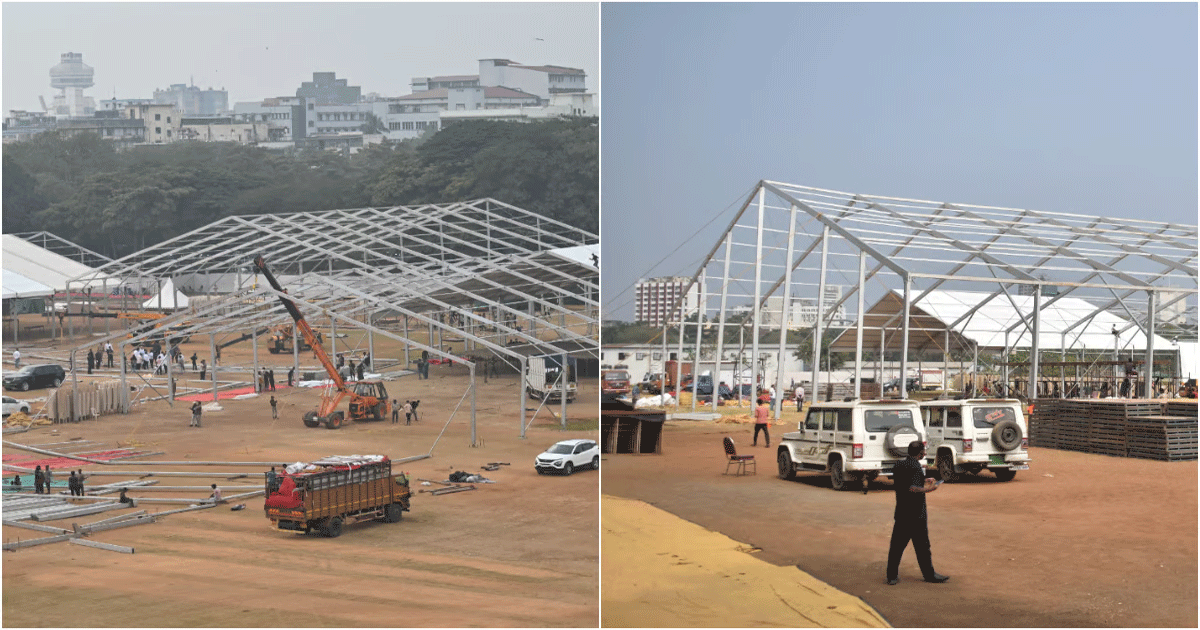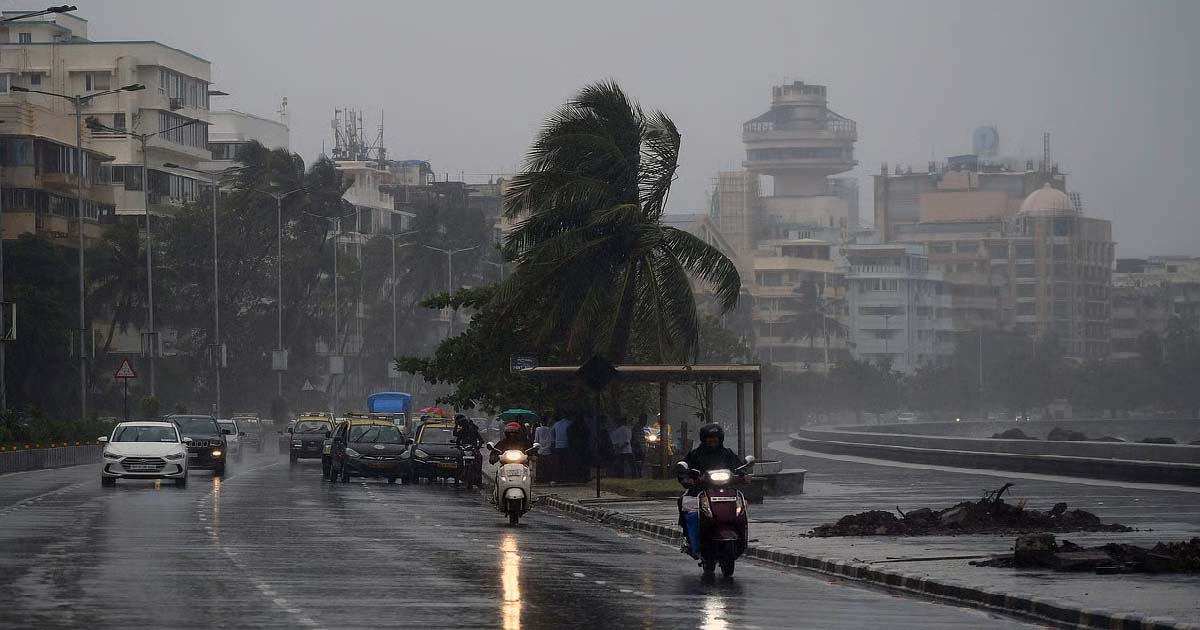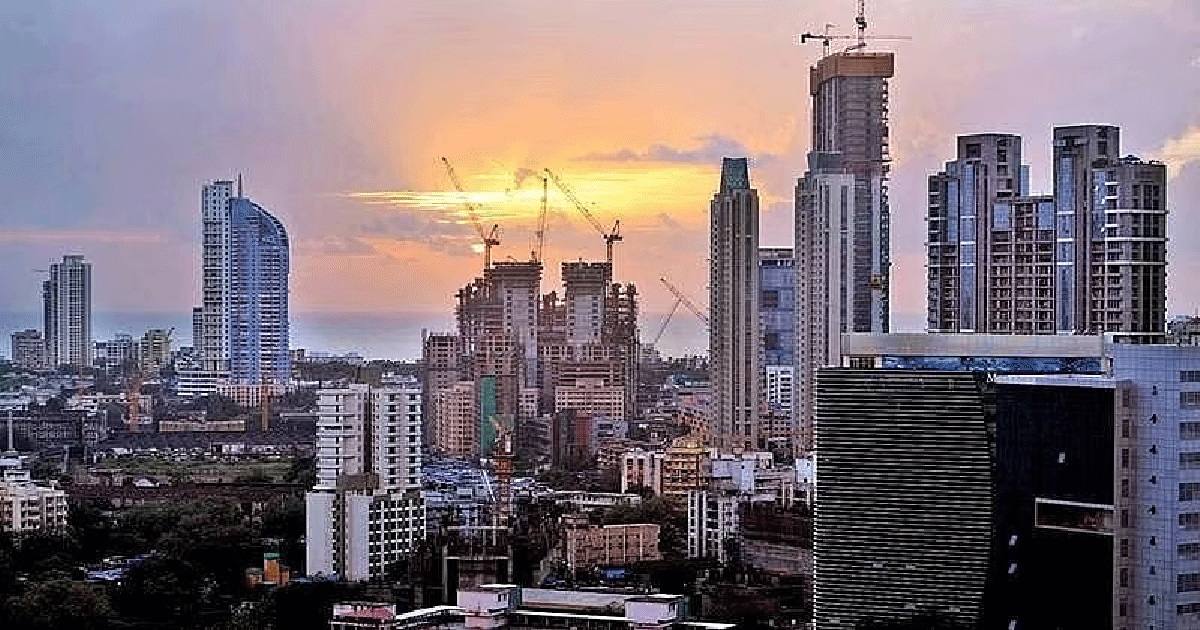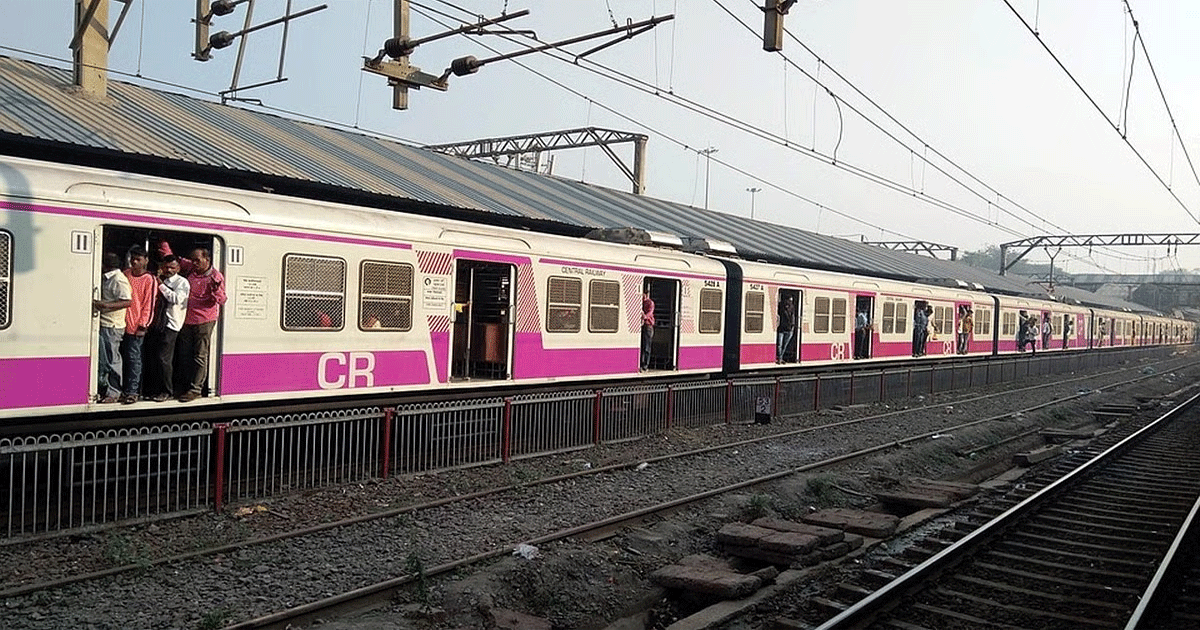Maharashtra
Maharashtra: PM Modi To Preside Over Mahayuti Swearing-In Ceremony As Devendra Fadnavis Gears Up For Third Stint As CM

Azad Maidan in Mumbai, just across from the BMC headquarters, is set to witness an electrifying gathering this evening as Prime Minister Narendra Modi arrives to preside over the swearing-in of the newly elected BJP-led Mahayuti government in Maharashtra.
The event, slated for 5:30 pm, will mark a significant political moment, with only Chief Minister Devendra Fadnavis and two deputy chief ministers taking their oaths at this stage. The event promises to be grand and is expected to host around 2,000 VVIPs and an estimated 40,000 BJP supporters—a testament to the political clout and support Fadnavis commands. Full details regarding the cabinet composition and portfolio assignments are expected to be finalized later.
Final Cabinet
While Fadnavis prepares to step into the role of chief minister for the third time, the final cabinet blueprint remains uncertain. Earlier on Wednesday morning, the political drama in Maharashtra, spanning over 11 days, reached its conclusion with the BJP leadership naming Devendra Fadnavis as its choice for Chief Minister. The announcement came after an intense period of speculation following the Mahayuti alliance’s decisive victory in the state assembly elections held on November 20. The air was thick with anticipation as party leaders, stakeholders, and even the public waited for clarity on who would lead India’s financial capital into its next chapter.
In his address at the legislature party meeting, Fadnavis, who has become synonymous with the BJP’s successful runs in Maharashtra, expressed heartfelt gratitude. He credited the alliance’s success to Prime Minister Narendra Modi’s leadership and underscored the slogans that have now become rallying cries: “Ek Hai To Safe Hai” and “Modi Hai To Mumkin Hai.” These words encapsulate the confidence and unity the party aims at projecting since its landslide victory.
“I bow before the people for giving us such a massive mandate,” Fadnavis said, acknowledging the people’s faith that has paved his way to the Chief Minister’s seat. The process leading up to this moment involved a meeting of the party’s core committee, where key figures such as state BJP unit chief Chandrashekhar Bawankule, senior leaders like Raosaheb Danve, and even former Chief Ministers like Ashok Chavan deliberated on the final decision.
In attendance were BJP stalwarts Sudhir Mungantiwar, Pankaja Munde, and Ashish Shelar, as well as central observers like Union Finance Minister Nirmala Sitharaman and ex-CM of Gujarat, Vijay Rupani. The proposal for Fadnavis’ nomination was put forward by Rupani and unanimously approved by all senior members, reinforcing his position as the party’s top pick. Following the legislative announcement, Fadnavis met with Maharashtra Governor CP Radhakrishnan at Raj Bhavan. The Governor formally invited him to form the next government.
Addressing the press afterward, Fadnavis was succinct and strategic. “I have full faith that he will stand by us… We will fulfill the promises made to the people of Maharashtra,” he asserted. The role of governance, he emphasized, would be collective, with every decision taken by a consensus-driven leadership structure. A defining moment came when Fadnavis addressed Eknath Shinde, whose faction of Shiv Sena played a critical role in shaping the current political landscape.
“I met Eknath Shinde yesterday and told him that it is the wish of both the Shiv Sena and Mahayuti members that he should be with us in this government. I have full faith that he will be with us,” Fadnavis said, hinting at an inclusive governance model that blends the diverse strands of the alliance.
Cheeky Banter
Adding a note of levity, a cheeky exchange at Raj Bhavan sparked laughter. When asked about the oath-taking ceremony, Shinde joked about waiting until evening, to which Ajit Pawar playfully responded, “I will take it and not wait.” To this, Shinde quipped that Ajit Pawar has experience in taking an oath both in the morning and evening. The remark was a nod to their prior, dramatic stint in 2019, when the duo had briefly assumed office before the alliance crumbled within hours. The back-and-forth was a reminder of Maharashtra’s turbulent political history and the seasoned wits of its players.
Third Term
Fadnavis’ journey has been marked by twists and turns. In 2014, at age 44, he made history as Maharashtra’s Chief Minister, being the second youngest to do so after Sharad Pawar. That tenure, though significant, ended in a rift with the Shiv Sena in 2019 over a power-sharing dispute, leading to a brief, 80-hour government that collapsed when Ajit Pawar rejoined the NCP. In 2022, after Eknath Shinde’s rebellion brought down the Maha Vikas Aghadi (MVA) government, Fadnavis was expected to take over the CM’s post but settled for the Deputy Chief Minister role under Shinde.
This third term, therefore, represents a moment of redemption and a culmination of years of political maneuvering. The BJP’s resounding success in the elections—132 out of 149 seats contested—underscored the strong support from the RSS and the organizational machinery that has propelled Fadnavis into the state’s top seat once again. His leadership is expected to bring continuity, stability, and an ambitious agenda aimed at consolidating the BJP’s stronghold and fulfilling the promises made to the electorate.
As the countdown to the swearing-in ceremony begins, the question looms: can Devendra Fadnavis use this third term to transform his political aspirations into a legacy of effective governance? The state watches with bated breath, ready for the next chapter in Maharashtra’s political saga.
Maharashtra
Mumbai Weather Update: City To See Light To Moderate Showers With Cloudy Skies Today; No Rain Alert For Next Few Days

WETHER
Mumbai: Mumbai woke up to scattered light rain showers on Friday morning. Though the city received rains in the early hours, the weather department has not issued any rain alert for today.
According to the IMD, the city would see an overcast sky with intermittent light showers, while a few areas may receive moderate spells. However, there is no forecast of heavy or widespread rainfall. Maximum temperature is likely to touch 28°C, while the minimum may settle at 25°C. Winds near the coast are expected to remain light to moderate.
Neighbouring Thane and Navi Mumbai are set to experience similar conditions. Residents can expect drizzle to moderate showers through the day, with no significant rainfall activity on the radar. Cloudy skies will persist, and the weather is likely to remain humid. Daytime temperatures are expected to hover around 28°C, while the night temperature will remain between 24°C and 25°C.
In Palghar, skies will stay overcast, and the rainfall pattern is expected to be uneven. While some pockets may only see light drizzle, others could receive moderate spells. The weather confirmed that no weather alert has been issued for the district. Maximum temperature is forecast at 28°C and minimum at 25°C, with conditions expected to remain damp and humid.
Further down the Konkan coast, Raigad, Ratnagiri and Sindhudurg districts, which witnessed heavy rain over the past few days, are also expected to see a decline in intensity. IMD officials said only light to moderate showers are likely, accompanied by cloudy weather.
The department clarified that there is no threat of heavy rain on Friday. Coastal winds in these regions may blow slightly stronger than in Mumbai and Thane. Daytime temperature could reach 29°C, while the minimum will remain around 25°C.
Maharashtra
Maharashtra Tops In Millionaire Growth With 1.78 Lakh Wealthy Households

Mumbai: The number of millionaire households in Maharashtra has grown by 194% to 1.78 lakhs in the last four years, which is the highest in the country. According to a latest wealth report, Mumbai alone hosts 1.42 lakh millionaire households with Maharashtra being the preferred investment destination for 43% of Indian millionaires.
India now has 8.71 lakh millionaire households, families with a net worth of at least 8.5Cr, increasing by 90% from 4.58 lakh in 2021, revealed the ‘Mercedes Benz-Hurun India Wealth Report 2025’ launched on Thursday. The report states that the number of such millionaire families have grown by 445% from 2017 whereas only 0.01% became billionaires. However, these households comprise only 0.31% of the total households in India, highlighting the growing wealth disparity in the country.
Notably, the report revealed that Maharashtra leads the country in terms of millionaire households, 1.78 lakh, recording a 194% growth since 2021. Mumbai, the country’s financial capital, alone hosts 1.42 lakh millionaire families, which is again the highest in the country, followed by 68,200 in New Delhi. The report stated that the economic expansion of Maharashtra, which is home to 471 individuals featured in the ‘Hurun India Rich List 2024’, is underpinned by a 55% increase in its gross state domestic product (GSDP) between 2020-21 and 2023-24, crossing Rs40 lakh crore. Similarly, Mumbai accounts for 80% of the state’s total wealth, backed by 55% GSDP growth.
Maharashtra stood out as the most preferred investment destination in India for millionaires, with 43% of them choosing it over Gujarat, Karnataka and Delhi NCR, revealed the ‘Mercedes-Benz Hurun India Luxury Consumer Survey 2025’, also launched on Thursday. The survey revealed that stocks, real estate, and gold remain the top asset choices for millionaires with 51% expecting Indian real estate to grow in the next two years, while 38% believe it will remain stable.
Anas Rahman Junaid, founder and chief researcher at Hurun India, said, “I am struck by the extraordinary upward mobility we’re witnessing in India. This democratisation of prosperity speaks to the resilience of our economy, with opportunity spreading to millions of new wealth creators. We project India’s millionaires could double to around 1.7 to 2 million households in the next decade. Powered by our young demographic, technology and entrepreneurial spirit, India is poised to become the world’s fastest-growing wealth hub, gradually closing the gap with the leading economies.
Santosh Iyer, MD and CEO of Mercedes-Benz India, highlighted that the millionaires are also quickly shifting towards luxury electric vehicles (EVs) in comparison to the overall shift in general EVs. He stated that while the overall shift to EV is around 4%, luxury car owners record an 11% shift. “India’s growth story underscores the resilience and transformation of the economy, driven by a burgeoning domestic market and soaring aspiration of today’s young generation. Mercedes-Benz remains a symbol of social prestige, financial affluence and unmatched desirability,” he added.
Maharashtra
Mumbai News: Central Railway’s Sector-Wise Local Train Proposal Sparks Outrage Among Commuters; Officials Call It ‘Impractical’

Mumbai: A controversial proposal by the Central Railway’s (CR) Mumbai division to overhaul the suburban railway system by segregating it into sector-wise corridors—akin to metro train operations—has ignited widespread backlash from commuters and railway officials alike.
Originally presented to the Railway Minister last year, the proposal aims to increase suburban train frequency to one every three minutes during peak hours by dividing the existing network into eight operational corridors.
These would include routes such as CSMT-Thane (slow), Thane-Kalyan (slow), Kalyan-Kasara (slow), CSMT-Kalyan (fast), CSMT-Panvel (slow), Belapur-Uran (slow), and Thane-Nerul/Vashi (slow), among others.
Although the presentation claims that this move could transform Mumbai’s local train operations, a fierce debate has erupted over the practicality of the leaked proposal.
“This proposal is unadulterated absurdity. The person who prepared it has no idea about Mumbai and has clearly never used the Mumbai suburban network as a means of transport for work,” said former General Manager of Central Railway, Subodh Jain
According to a senior CR official, who declined to be named, “The plan may look good on paper, but in reality, it’s completely impractical. It would involve mass transhipment of passengers at busy junctions like Thane and Kalyan—already under tremendous pressure.”
“Catching one train itself is a big hassle—now imagine the inconvenience of changing 3 to 4 trains in a single journey and the extra time lost at each station,” said a senior Central Railway officer.
“The crowding at transhipment stations will be unimaginable. Passengers who manage to get a seat in the first train will likely lose it in the connecting train, as those already standing will rush to board first.”
The elaborate plan (FPJ has a copy) involves running services sector-wise — with the first sector operating only between CSMT and Thane on the slow line, the second sector covering CSMT to Kalyan on the fast line, and the third sector managing operations between Thane and Kalyan on the slow corridor, as well as Kalyan to Kasara and Kalyan to Karjat.
While the presentation made by the Mumbai Division under the leadership of the then Divisional Railway Manager, Rajnish Goyal, claims that sector-wise operations could boost efficiency and frequency, even internal voices remain skeptical.
The concerns are not just logistical but also practical—crowding at transhipment points, loss of seating priority, added travel time, and passenger confusion could worsen the already strained infrastructure.
Sources within CR have hinted that the proposal may have been “deliberately leaked” this week, rekindling both internal debates and public scrutiny.
Passengers, who form the backbone of Mumbai’s lifeline, expressed their frustration across social media platforms and in interviews.
Jayant Sathe, a daily commuter from Kalyan, remarked, “Whoever designed this plan clearly doesn’t understand Mumbai’s suburban travel. Changing trains at Thane after boarding from Badlapur? That’s completely unrealistic.”
The proposal has also drawn sharp criticism online. Devesh Tiwari posted on X (formerly Twitter), “This is a stupid plan. It will create horrible bottlenecks at terminal stations. Why can’t CR reduce headway to 120 or 90 seconds during peak hours? It’s simple tech, but there’s zero willpower to implement it.”
Another internet User @warrenbhai added posted on X “Changing and crossing FOBs will be a nightmare. A lot of us catch up on sleep during the long travel. That won’t be possible anymore.”
Another commuter, Kumar Saket, called the proposal the “joke of the month,” while Bharat Soni criticized what he termed the “Reel Minister” for making hollow promises, stating:
“What’s new in promising 3-min frequency? WR already does that. CR used to run locals every 5 minutes up to Kalyan. Try giving us 15-min services up to Kasara and Karjat—that would be actual progress.”
@smartkalyan7 posted on X “Instead of this jumlabazi, build a new line between Kalyan and Borivali. Thousands waste time commuting to the western suburbs via Dadar.”
-

 Crime3 years ago
Crime3 years agoClass 10 student jumps to death in Jaipur
-

 Maharashtra12 months ago
Maharashtra12 months agoMumbai Local Train Update: Central Railway’s New Timetable Comes Into Effect; Check Full List Of Revised Timings & Stations
-

 Maharashtra11 months ago
Maharashtra11 months agoMumbai To Go Toll-Free Tonight! Maharashtra Govt Announces Complete Toll Waiver For Light Motor Vehicles At All 5 Entry Points Of City
-

 Maharashtra12 months ago
Maharashtra12 months agoFalse photo of Imtiaz Jaleel’s rally, exposing the fooling conspiracy
-

 National News11 months ago
National News11 months agoMinistry of Railways rolls out Special Drive 4.0 with focus on digitisation, cleanliness, inclusiveness and grievance redressal
-

 Crime11 months ago
Crime11 months agoBaba Siddique Murder: Mumbai Police Unable To Get Lawrence Bishnoi Custody Due To Home Ministry Order, Says Report
-

 Maharashtra10 months ago
Maharashtra10 months agoMaharashtra Elections 2024: Mumbai Metro & BEST Services Extended Till Midnight On Voting Day
-

 National News12 months ago
National News12 months agoJ&K: 4 Jawans Killed, 28 Injured After Bus Carrying BSF Personnel For Poll Duty Falls Into Gorge In Budgam; Terrifying Visuals Surface












